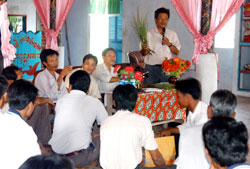A programme to curb pollution from insecticide residues by targeting 100 hot spots throughout the nation will cost VND1.01 trillion ($48.4 million).
 |
| An official of the Mekong Delta Soc Trang Province's Plant Protection Department guides farmers how to use insecticides correctly |
In Nghe An alone there were about 270 polluted spots that needed to be cleared by 2025 and 31 in Ha Tinh. Most chemical warehouses built since the 1980s for storing war-time chemicals were now surrounded by residential areas. The warehouses had seriously deteriorated, the survey showed.
Currently, Vietnam has no official report assessing the environment impact of insecticides nationwide and locals are still cultivating land, raising livestock and using water from wells.
Nguyen Xuan Hai, who lives about 500m away from an insecticide warehouse in Nghe An Province's Dien Yen Commune, said he knew the chemicals were toxic but he had become used to the smell. He said his family had no other place to go.
Hai said he was one of four labourers who had worked as porters at the insecticide warehouse. The other three had died of cancer and he was now suffering serious asthma.
In Ha Tinh Province's Khanh Loc Commune, the insecticide lindane is estimated to be 9.3 times higher than allowed in the environment near a primary school for 500 pupils.
"We told teachers to close all windows but the smell is really strong whenever it is sunny," principal Hoang Thi Ai Khanh said.
Tran Ngoc Dinh, of the VietnamEnvironment Administration's Department of Waste Management and Environmental Improvement, said lindane was among 12 poisonous chemicals that could exist in the environment for a very long time.
Lindane has been banned in 52 countries and restricted in 33 others.
"It's easy to treat pesticide residues in stations but treatment in polluted areas is quite complicated and costs a lot of money," he said.
"It costs $2 to treat 1kg of chemical residue but up to $200 to treat 1kg of chemical soaked into the land and up to $2,000 to clean water resources."
Worse, in polluted areas, toxic chemicals were improperly buried, spilled or scattered during transport. This required comprehensive treatment on land and in water sources that cost much more money, he said.
In the past years, the Vietnam Environmental Administration, in co-operation with local authorities, has built cement trenches in hot spots to bury hundreds of tonnes of insecticide residues.
The administration has also built fences, dredged canals with peat on the bottom and planted trees to improve the polluted land.
In Mau 2 Village in Nghe An Province, the administration built a 2m deep embankment around polluted areas and a kind of grass to absorb toxic chemicals in land.
Mau 2 Village resident Pham Trong Xuan said the smell had reduced and the water of his family's well was safe.
Apart from on-going measures, such as educating people in contaminated areas about risks and to avoid well water, the new programme would treat polluted land and water, isolate seriously polluted areas and build preventive systems to avoid spreading of toxic chemicals.
The ministry will be in charge of the programme.

Leave your comment on this story